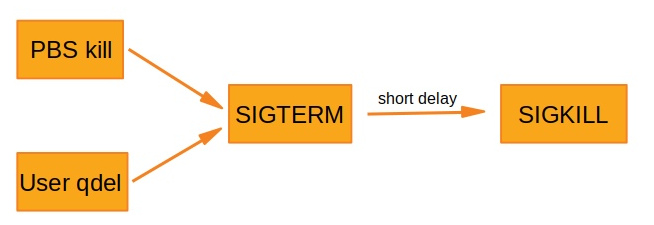Trap command usage
To manage proper cleaning of scratch space, users can take advantage of trap command and clean_scratch script.
trap command allows users to catch signals from OS and execute a code when they occur.
clean_scratch is a systemwide-installed MetaCentrum utility that removes the content of the current job's scratch directory.
Tip
While it is perfectly OK to use the trap command instruction upon the normal ending of a job, in case the job is killed (either by PBS or user) the results may be not always what the user expected, depending on the amount of data in scratch.
Trap the EXIT
trap 'clean_scratch' EXIT
EXIT is not a signal, but for the purpose of trap command it can be treated in the same way.
EXIT happens when the script ends, either by executing the last line or via the exit command somewhere in the bash script:
#!/bin/bash
cp fileXXX "$SCRATCHDIR/" || { echo >&2 "cp of fileXXX failed!"; exit 1; }
fileXXX failed, the job will end AND the scratch space will be cleaned.
Trap the TERM
trap 'clean_scratch' TERM
TERM is a OS signal a job receives when it is terminated from "outside", i.e. when it does not finish in normal way.
The job may be killed either by PBS or by the user (qdel command):

The batch script receives SIGTERM signal. There is no way how to distinguish whether the job was killed by PBS or by the user. Upon receiving the SIGTERM, the running process may take a variety of actions - it may stop immediately, or it may attempt to clean up and stop, or it may do nothing. If the process keeps running, the SIGTERM signal is after some delay followed by SIGKILL (equivalent to kill -9), which stops it immediately.
- What action is taken upon receiving a
SIGTERMcan be defined viatrapcommand. SIGKILLcannot be trapped, ignored nor reacted to.
This construction is useful to clean up after failed jobs where the user is not interested in any data produced by the job and in such cases we encourage users to apply it (see section below for potential pitfalls.)
Trap both EXIT and TERM
trap 'clean_scratch' EXIT TERM
This construction combines both purposes mentioned above.
Caveats
Tip
Currently the delay between SIGTERM and SIGKILL is 10 seconds.
Depending on the amount of data in scratch, some code constructions within the trap command may run to and end, while other may not. This can lead to unexpected behaviour.
Example 1
Idea: if the job crashes, copy away potentially valuable files, then clean the scratch.
trap 'cp all_checkpoint_files somewhere_safe/ ; clean_scratch' TERM
Potential hazard: if the checkpoint files are large and/or numerous, the copy operation may not finish in time before being interrupted by SIGKILL signal. Some of the files may be missing and/or incomplete. Moreover the scratch directory will not be cleaned.
Solution: If you already know that your job produces many and/or large files which you will need to retrieve in case the job crashes, it is safer to just let yourself know about it by adding a line to output:
trap 'echo "$PBS_JOBID job failed. Retrieve the files from $SCRATCHDIR on `hostname -f` node, then clean the scratch manually" /storage/..../' TERM
Example 2
Idea: Using trap to clean scratches upon job exit poses no dangers.
Potential hazard: Suppose the user adds the trap with the purpose to clean up after the script has run to an end, then adds some small sanity check, e.g.:
#!/bin/bash
...
trap 'clean_scratch' EXIT
...
./potentially_long_calculation_producing_result_files
test -n some-directory || { echo >&2 "Directory does not exist!"; exit 1; }
cp result_files somewhere/
...
In this case, the scratch directory would be cleaned before the output files would be copied away.
Solution: When adding any sanity check, keep this risk in mind.